Exploring Green Cloud Computing: Challenges and Solutions
VerifiedAdded on 2023/06/11
|12
|3058
|388
Case Study
AI Summary
This case study explores Green Cloud Computing and its impact on the environment. It discusses the increasing energy consumption due to the growth of data centers and its adverse effects, such as carbon footprints and global warming. The study identifies research issues like the high costs associated with eco-friendly data centers, the challenge of balancing efficiency with energy conservation, and the lack of awareness and government policies. Proposed solutions include government funding, training programs, standardized policies, and the development of energy management systems. The study also highlights the advantages of green cloud computing, such as energy conservation and improved power management, as well as disadvantages like high costs and security concerns. Finally, it examines the applications of green cloud computing in industries, including power management, virtualization, and recycling. Desklib provides access to this and other solved assignments for students.
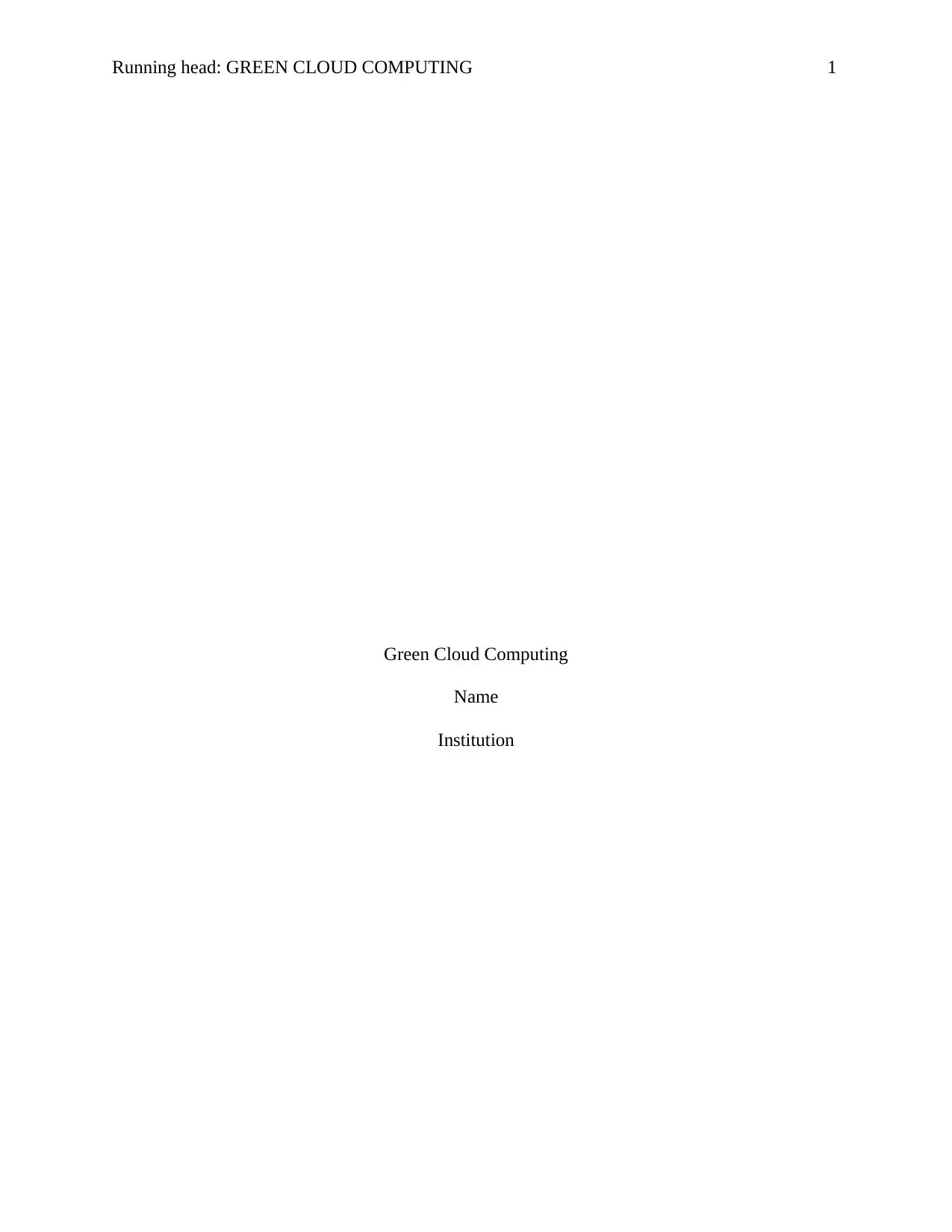
Running head: GREEN CLOUD COMPUTING 1
Green Cloud Computing
Name
Institution
Green Cloud Computing
Name
Institution
Paraphrase This Document
Need a fresh take? Get an instant paraphrase of this document with our AI Paraphraser
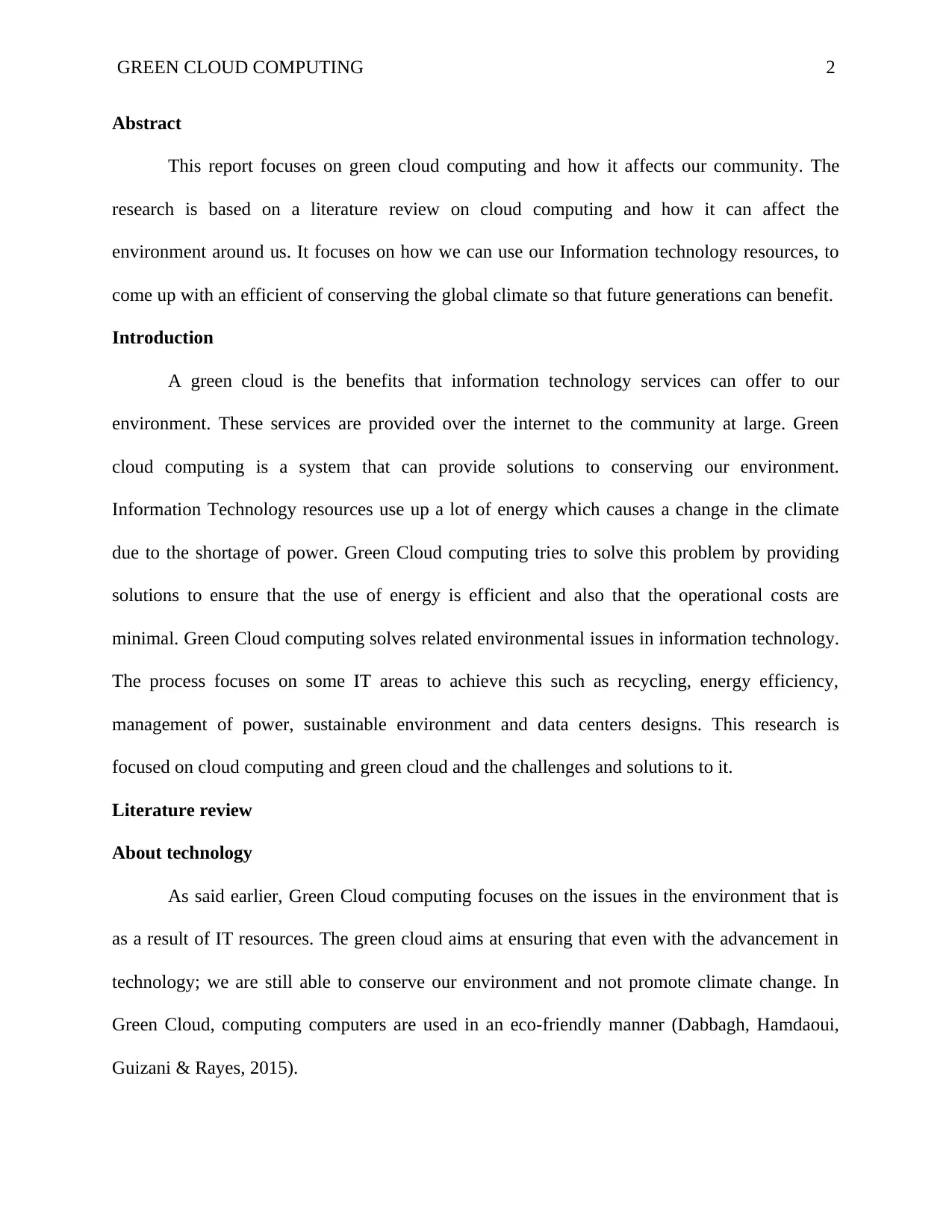
GREEN CLOUD COMPUTING 2
Abstract
This report focuses on green cloud computing and how it affects our community. The
research is based on a literature review on cloud computing and how it can affect the
environment around us. It focuses on how we can use our Information technology resources, to
come up with an efficient of conserving the global climate so that future generations can benefit.
Introduction
A green cloud is the benefits that information technology services can offer to our
environment. These services are provided over the internet to the community at large. Green
cloud computing is a system that can provide solutions to conserving our environment.
Information Technology resources use up a lot of energy which causes a change in the climate
due to the shortage of power. Green Cloud computing tries to solve this problem by providing
solutions to ensure that the use of energy is efficient and also that the operational costs are
minimal. Green Cloud computing solves related environmental issues in information technology.
The process focuses on some IT areas to achieve this such as recycling, energy efficiency,
management of power, sustainable environment and data centers designs. This research is
focused on cloud computing and green cloud and the challenges and solutions to it.
Literature review
About technology
As said earlier, Green Cloud computing focuses on the issues in the environment that is
as a result of IT resources. The green cloud aims at ensuring that even with the advancement in
technology; we are still able to conserve our environment and not promote climate change. In
Green Cloud, computing computers are used in an eco-friendly manner (Dabbagh, Hamdaoui,
Guizani & Rayes, 2015).
Abstract
This report focuses on green cloud computing and how it affects our community. The
research is based on a literature review on cloud computing and how it can affect the
environment around us. It focuses on how we can use our Information technology resources, to
come up with an efficient of conserving the global climate so that future generations can benefit.
Introduction
A green cloud is the benefits that information technology services can offer to our
environment. These services are provided over the internet to the community at large. Green
cloud computing is a system that can provide solutions to conserving our environment.
Information Technology resources use up a lot of energy which causes a change in the climate
due to the shortage of power. Green Cloud computing tries to solve this problem by providing
solutions to ensure that the use of energy is efficient and also that the operational costs are
minimal. Green Cloud computing solves related environmental issues in information technology.
The process focuses on some IT areas to achieve this such as recycling, energy efficiency,
management of power, sustainable environment and data centers designs. This research is
focused on cloud computing and green cloud and the challenges and solutions to it.
Literature review
About technology
As said earlier, Green Cloud computing focuses on the issues in the environment that is
as a result of IT resources. The green cloud aims at ensuring that even with the advancement in
technology; we are still able to conserve our environment and not promote climate change. In
Green Cloud, computing computers are used in an eco-friendly manner (Dabbagh, Hamdaoui,
Guizani & Rayes, 2015).
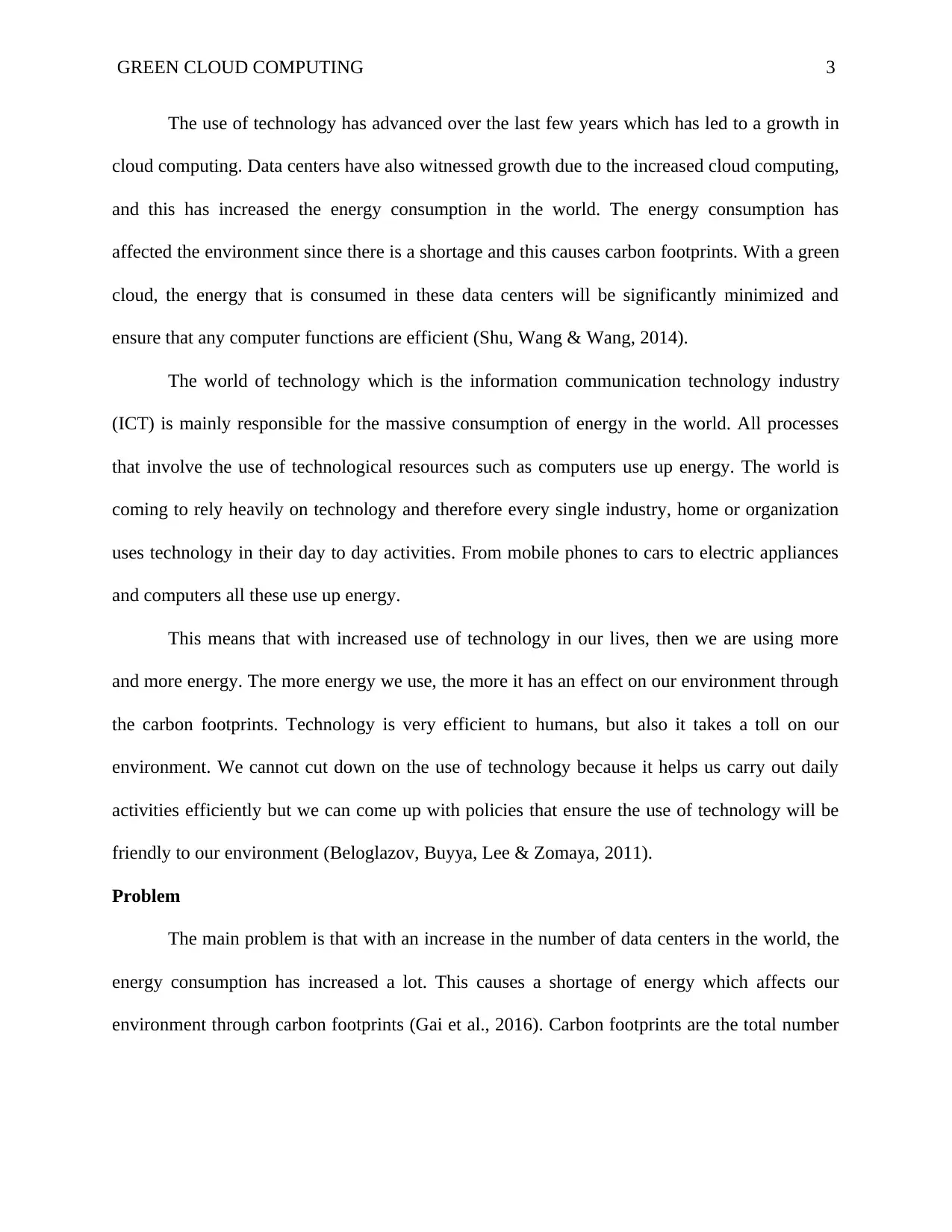
GREEN CLOUD COMPUTING 3
The use of technology has advanced over the last few years which has led to a growth in
cloud computing. Data centers have also witnessed growth due to the increased cloud computing,
and this has increased the energy consumption in the world. The energy consumption has
affected the environment since there is a shortage and this causes carbon footprints. With a green
cloud, the energy that is consumed in these data centers will be significantly minimized and
ensure that any computer functions are efficient (Shu, Wang & Wang, 2014).
The world of technology which is the information communication technology industry
(ICT) is mainly responsible for the massive consumption of energy in the world. All processes
that involve the use of technological resources such as computers use up energy. The world is
coming to rely heavily on technology and therefore every single industry, home or organization
uses technology in their day to day activities. From mobile phones to cars to electric appliances
and computers all these use up energy.
This means that with increased use of technology in our lives, then we are using more
and more energy. The more energy we use, the more it has an effect on our environment through
the carbon footprints. Technology is very efficient to humans, but also it takes a toll on our
environment. We cannot cut down on the use of technology because it helps us carry out daily
activities efficiently but we can come up with policies that ensure the use of technology will be
friendly to our environment (Beloglazov, Buyya, Lee & Zomaya, 2011).
Problem
The main problem is that with an increase in the number of data centers in the world, the
energy consumption has increased a lot. This causes a shortage of energy which affects our
environment through carbon footprints (Gai et al., 2016). Carbon footprints are the total number
The use of technology has advanced over the last few years which has led to a growth in
cloud computing. Data centers have also witnessed growth due to the increased cloud computing,
and this has increased the energy consumption in the world. The energy consumption has
affected the environment since there is a shortage and this causes carbon footprints. With a green
cloud, the energy that is consumed in these data centers will be significantly minimized and
ensure that any computer functions are efficient (Shu, Wang & Wang, 2014).
The world of technology which is the information communication technology industry
(ICT) is mainly responsible for the massive consumption of energy in the world. All processes
that involve the use of technological resources such as computers use up energy. The world is
coming to rely heavily on technology and therefore every single industry, home or organization
uses technology in their day to day activities. From mobile phones to cars to electric appliances
and computers all these use up energy.
This means that with increased use of technology in our lives, then we are using more
and more energy. The more energy we use, the more it has an effect on our environment through
the carbon footprints. Technology is very efficient to humans, but also it takes a toll on our
environment. We cannot cut down on the use of technology because it helps us carry out daily
activities efficiently but we can come up with policies that ensure the use of technology will be
friendly to our environment (Beloglazov, Buyya, Lee & Zomaya, 2011).
Problem
The main problem is that with an increase in the number of data centers in the world, the
energy consumption has increased a lot. This causes a shortage of energy which affects our
environment through carbon footprints (Gai et al., 2016). Carbon footprints are the total number
⊘ This is a preview!⊘
Do you want full access?
Subscribe today to unlock all pages.

Trusted by 1+ million students worldwide
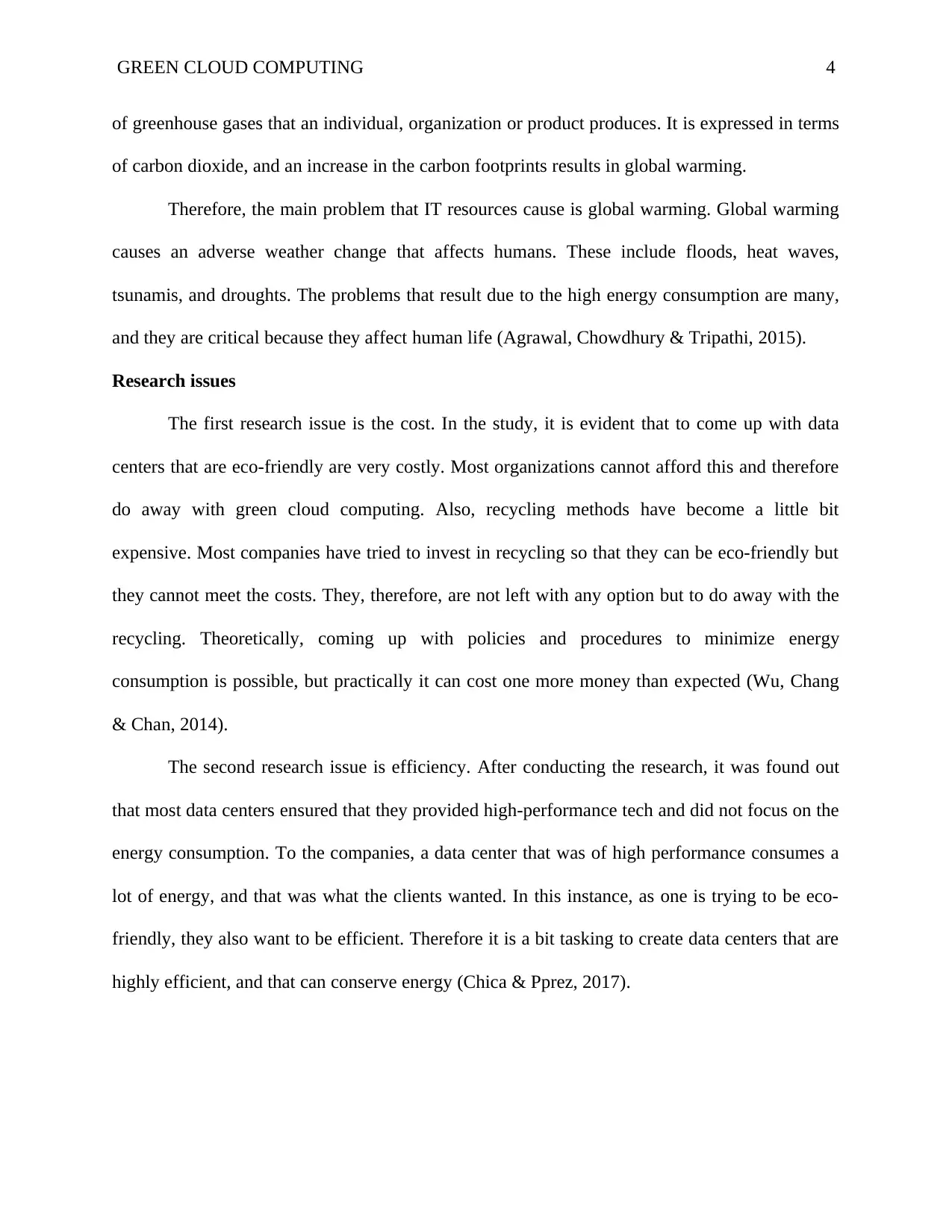
GREEN CLOUD COMPUTING 4
of greenhouse gases that an individual, organization or product produces. It is expressed in terms
of carbon dioxide, and an increase in the carbon footprints results in global warming.
Therefore, the main problem that IT resources cause is global warming. Global warming
causes an adverse weather change that affects humans. These include floods, heat waves,
tsunamis, and droughts. The problems that result due to the high energy consumption are many,
and they are critical because they affect human life (Agrawal, Chowdhury & Tripathi, 2015).
Research issues
The first research issue is the cost. In the study, it is evident that to come up with data
centers that are eco-friendly are very costly. Most organizations cannot afford this and therefore
do away with green cloud computing. Also, recycling methods have become a little bit
expensive. Most companies have tried to invest in recycling so that they can be eco-friendly but
they cannot meet the costs. They, therefore, are not left with any option but to do away with the
recycling. Theoretically, coming up with policies and procedures to minimize energy
consumption is possible, but practically it can cost one more money than expected (Wu, Chang
& Chan, 2014).
The second research issue is efficiency. After conducting the research, it was found out
that most data centers ensured that they provided high-performance tech and did not focus on the
energy consumption. To the companies, a data center that was of high performance consumes a
lot of energy, and that was what the clients wanted. In this instance, as one is trying to be eco-
friendly, they also want to be efficient. Therefore it is a bit tasking to create data centers that are
highly efficient, and that can conserve energy (Chica & Pprez, 2017).
of greenhouse gases that an individual, organization or product produces. It is expressed in terms
of carbon dioxide, and an increase in the carbon footprints results in global warming.
Therefore, the main problem that IT resources cause is global warming. Global warming
causes an adverse weather change that affects humans. These include floods, heat waves,
tsunamis, and droughts. The problems that result due to the high energy consumption are many,
and they are critical because they affect human life (Agrawal, Chowdhury & Tripathi, 2015).
Research issues
The first research issue is the cost. In the study, it is evident that to come up with data
centers that are eco-friendly are very costly. Most organizations cannot afford this and therefore
do away with green cloud computing. Also, recycling methods have become a little bit
expensive. Most companies have tried to invest in recycling so that they can be eco-friendly but
they cannot meet the costs. They, therefore, are not left with any option but to do away with the
recycling. Theoretically, coming up with policies and procedures to minimize energy
consumption is possible, but practically it can cost one more money than expected (Wu, Chang
& Chan, 2014).
The second research issue is efficiency. After conducting the research, it was found out
that most data centers ensured that they provided high-performance tech and did not focus on the
energy consumption. To the companies, a data center that was of high performance consumes a
lot of energy, and that was what the clients wanted. In this instance, as one is trying to be eco-
friendly, they also want to be efficient. Therefore it is a bit tasking to create data centers that are
highly efficient, and that can conserve energy (Chica & Pprez, 2017).
Paraphrase This Document
Need a fresh take? Get an instant paraphrase of this document with our AI Paraphraser
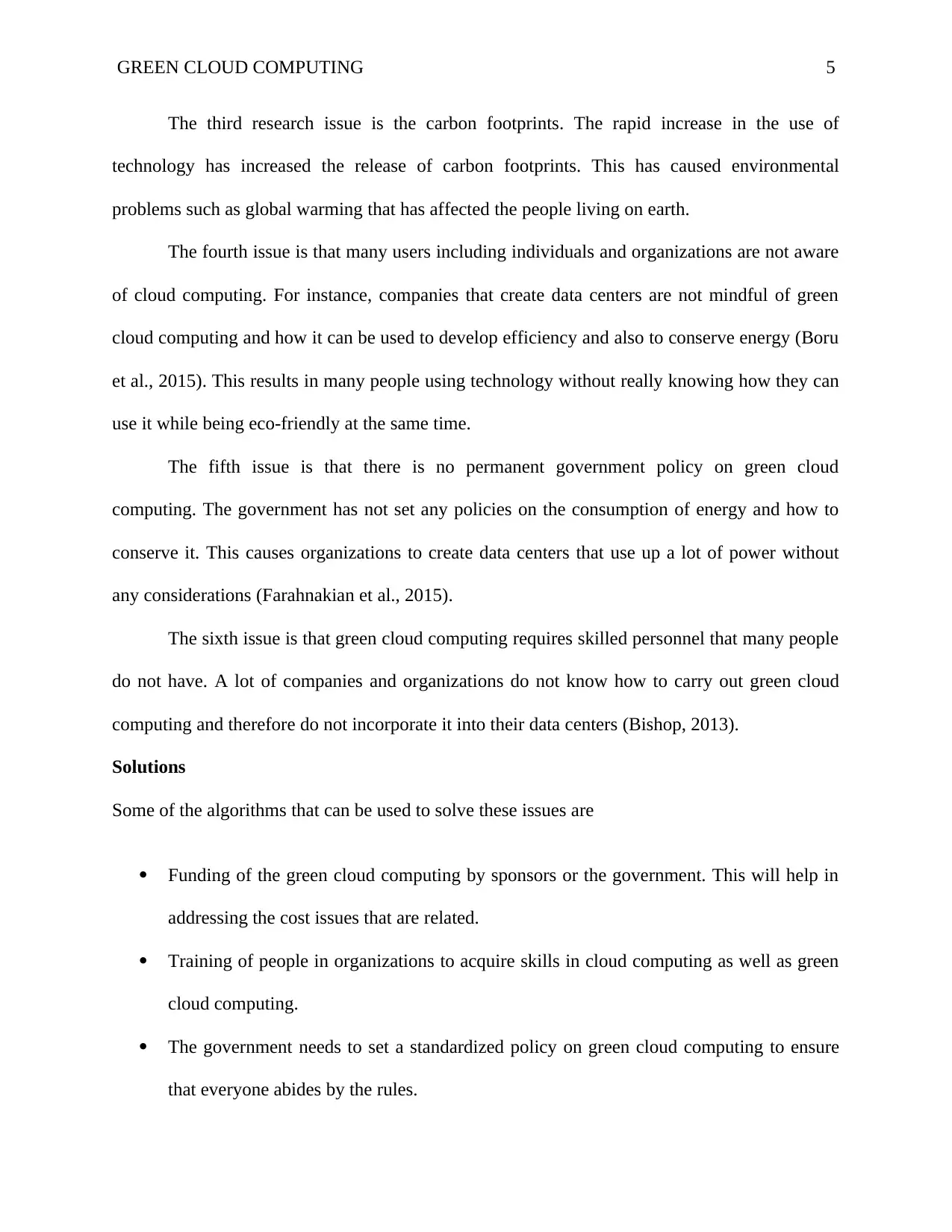
GREEN CLOUD COMPUTING 5
The third research issue is the carbon footprints. The rapid increase in the use of
technology has increased the release of carbon footprints. This has caused environmental
problems such as global warming that has affected the people living on earth.
The fourth issue is that many users including individuals and organizations are not aware
of cloud computing. For instance, companies that create data centers are not mindful of green
cloud computing and how it can be used to develop efficiency and also to conserve energy (Boru
et al., 2015). This results in many people using technology without really knowing how they can
use it while being eco-friendly at the same time.
The fifth issue is that there is no permanent government policy on green cloud
computing. The government has not set any policies on the consumption of energy and how to
conserve it. This causes organizations to create data centers that use up a lot of power without
any considerations (Farahnakian et al., 2015).
The sixth issue is that green cloud computing requires skilled personnel that many people
do not have. A lot of companies and organizations do not know how to carry out green cloud
computing and therefore do not incorporate it into their data centers (Bishop, 2013).
Solutions
Some of the algorithms that can be used to solve these issues are
Funding of the green cloud computing by sponsors or the government. This will help in
addressing the cost issues that are related.
Training of people in organizations to acquire skills in cloud computing as well as green
cloud computing.
The government needs to set a standardized policy on green cloud computing to ensure
that everyone abides by the rules.
The third research issue is the carbon footprints. The rapid increase in the use of
technology has increased the release of carbon footprints. This has caused environmental
problems such as global warming that has affected the people living on earth.
The fourth issue is that many users including individuals and organizations are not aware
of cloud computing. For instance, companies that create data centers are not mindful of green
cloud computing and how it can be used to develop efficiency and also to conserve energy (Boru
et al., 2015). This results in many people using technology without really knowing how they can
use it while being eco-friendly at the same time.
The fifth issue is that there is no permanent government policy on green cloud
computing. The government has not set any policies on the consumption of energy and how to
conserve it. This causes organizations to create data centers that use up a lot of power without
any considerations (Farahnakian et al., 2015).
The sixth issue is that green cloud computing requires skilled personnel that many people
do not have. A lot of companies and organizations do not know how to carry out green cloud
computing and therefore do not incorporate it into their data centers (Bishop, 2013).
Solutions
Some of the algorithms that can be used to solve these issues are
Funding of the green cloud computing by sponsors or the government. This will help in
addressing the cost issues that are related.
Training of people in organizations to acquire skills in cloud computing as well as green
cloud computing.
The government needs to set a standardized policy on green cloud computing to ensure
that everyone abides by the rules.
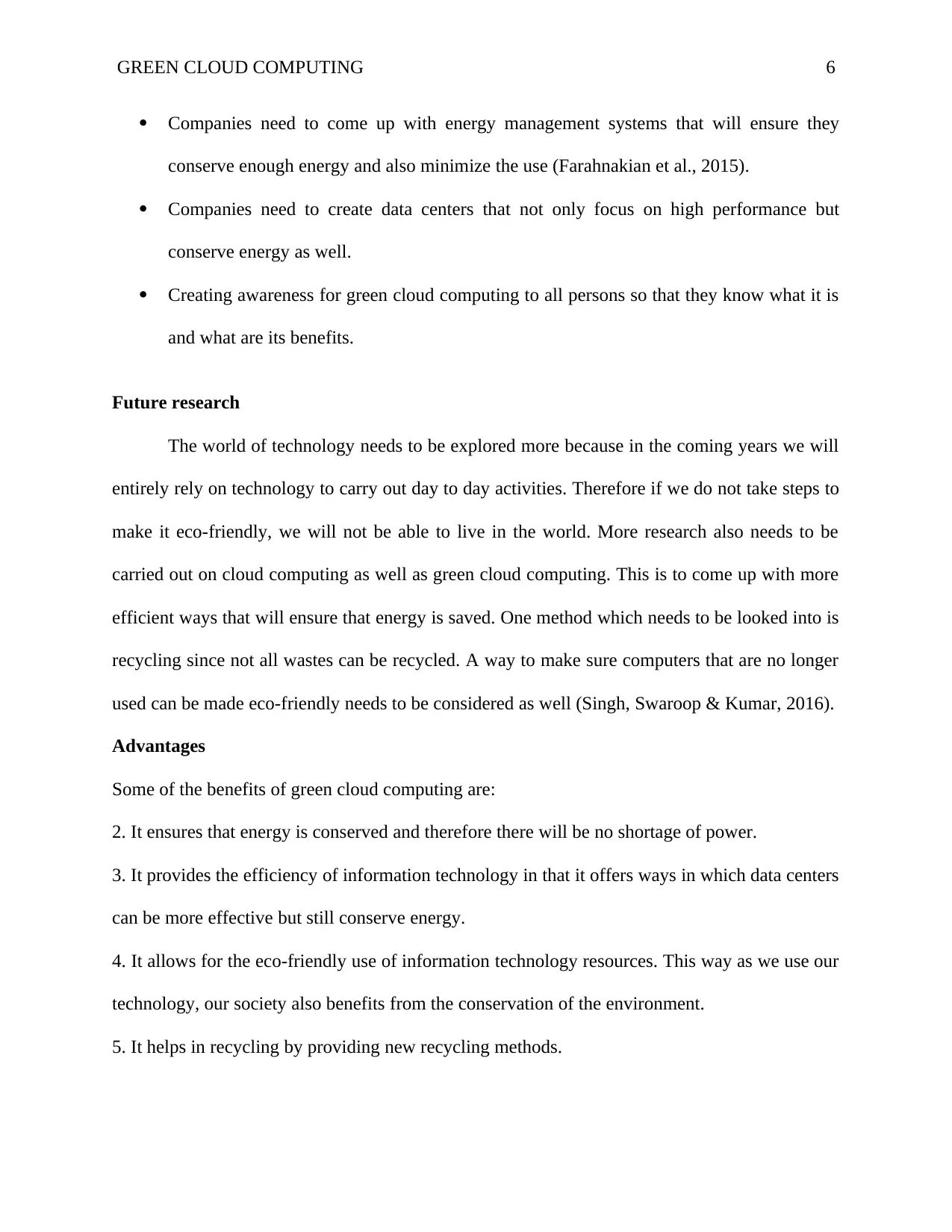
GREEN CLOUD COMPUTING 6
Companies need to come up with energy management systems that will ensure they
conserve enough energy and also minimize the use (Farahnakian et al., 2015).
Companies need to create data centers that not only focus on high performance but
conserve energy as well.
Creating awareness for green cloud computing to all persons so that they know what it is
and what are its benefits.
Future research
The world of technology needs to be explored more because in the coming years we will
entirely rely on technology to carry out day to day activities. Therefore if we do not take steps to
make it eco-friendly, we will not be able to live in the world. More research also needs to be
carried out on cloud computing as well as green cloud computing. This is to come up with more
efficient ways that will ensure that energy is saved. One method which needs to be looked into is
recycling since not all wastes can be recycled. A way to make sure computers that are no longer
used can be made eco-friendly needs to be considered as well (Singh, Swaroop & Kumar, 2016).
Advantages
Some of the benefits of green cloud computing are:
2. It ensures that energy is conserved and therefore there will be no shortage of power.
3. It provides the efficiency of information technology in that it offers ways in which data centers
can be more effective but still conserve energy.
4. It allows for the eco-friendly use of information technology resources. This way as we use our
technology, our society also benefits from the conservation of the environment.
5. It helps in recycling by providing new recycling methods.
Companies need to come up with energy management systems that will ensure they
conserve enough energy and also minimize the use (Farahnakian et al., 2015).
Companies need to create data centers that not only focus on high performance but
conserve energy as well.
Creating awareness for green cloud computing to all persons so that they know what it is
and what are its benefits.
Future research
The world of technology needs to be explored more because in the coming years we will
entirely rely on technology to carry out day to day activities. Therefore if we do not take steps to
make it eco-friendly, we will not be able to live in the world. More research also needs to be
carried out on cloud computing as well as green cloud computing. This is to come up with more
efficient ways that will ensure that energy is saved. One method which needs to be looked into is
recycling since not all wastes can be recycled. A way to make sure computers that are no longer
used can be made eco-friendly needs to be considered as well (Singh, Swaroop & Kumar, 2016).
Advantages
Some of the benefits of green cloud computing are:
2. It ensures that energy is conserved and therefore there will be no shortage of power.
3. It provides the efficiency of information technology in that it offers ways in which data centers
can be more effective but still conserve energy.
4. It allows for the eco-friendly use of information technology resources. This way as we use our
technology, our society also benefits from the conservation of the environment.
5. It helps in recycling by providing new recycling methods.
⊘ This is a preview!⊘
Do you want full access?
Subscribe today to unlock all pages.

Trusted by 1+ million students worldwide
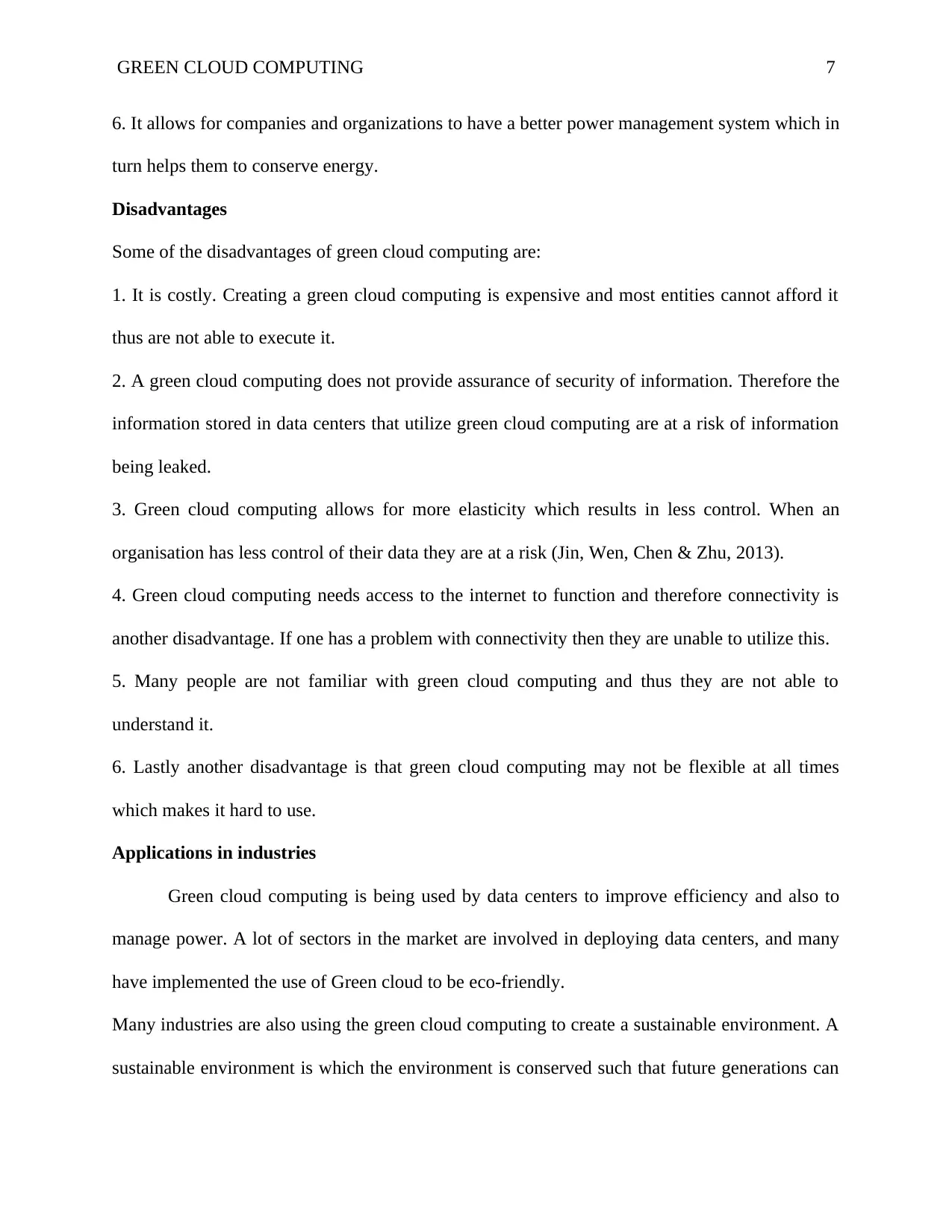
GREEN CLOUD COMPUTING 7
6. It allows for companies and organizations to have a better power management system which in
turn helps them to conserve energy.
Disadvantages
Some of the disadvantages of green cloud computing are:
1. It is costly. Creating a green cloud computing is expensive and most entities cannot afford it
thus are not able to execute it.
2. A green cloud computing does not provide assurance of security of information. Therefore the
information stored in data centers that utilize green cloud computing are at a risk of information
being leaked.
3. Green cloud computing allows for more elasticity which results in less control. When an
organisation has less control of their data they are at a risk (Jin, Wen, Chen & Zhu, 2013).
4. Green cloud computing needs access to the internet to function and therefore connectivity is
another disadvantage. If one has a problem with connectivity then they are unable to utilize this.
5. Many people are not familiar with green cloud computing and thus they are not able to
understand it.
6. Lastly another disadvantage is that green cloud computing may not be flexible at all times
which makes it hard to use.
Applications in industries
Green cloud computing is being used by data centers to improve efficiency and also to
manage power. A lot of sectors in the market are involved in deploying data centers, and many
have implemented the use of Green cloud to be eco-friendly.
Many industries are also using the green cloud computing to create a sustainable environment. A
sustainable environment is which the environment is conserved such that future generations can
6. It allows for companies and organizations to have a better power management system which in
turn helps them to conserve energy.
Disadvantages
Some of the disadvantages of green cloud computing are:
1. It is costly. Creating a green cloud computing is expensive and most entities cannot afford it
thus are not able to execute it.
2. A green cloud computing does not provide assurance of security of information. Therefore the
information stored in data centers that utilize green cloud computing are at a risk of information
being leaked.
3. Green cloud computing allows for more elasticity which results in less control. When an
organisation has less control of their data they are at a risk (Jin, Wen, Chen & Zhu, 2013).
4. Green cloud computing needs access to the internet to function and therefore connectivity is
another disadvantage. If one has a problem with connectivity then they are unable to utilize this.
5. Many people are not familiar with green cloud computing and thus they are not able to
understand it.
6. Lastly another disadvantage is that green cloud computing may not be flexible at all times
which makes it hard to use.
Applications in industries
Green cloud computing is being used by data centers to improve efficiency and also to
manage power. A lot of sectors in the market are involved in deploying data centers, and many
have implemented the use of Green cloud to be eco-friendly.
Many industries are also using the green cloud computing to create a sustainable environment. A
sustainable environment is which the environment is conserved such that future generations can
Paraphrase This Document
Need a fresh take? Get an instant paraphrase of this document with our AI Paraphraser
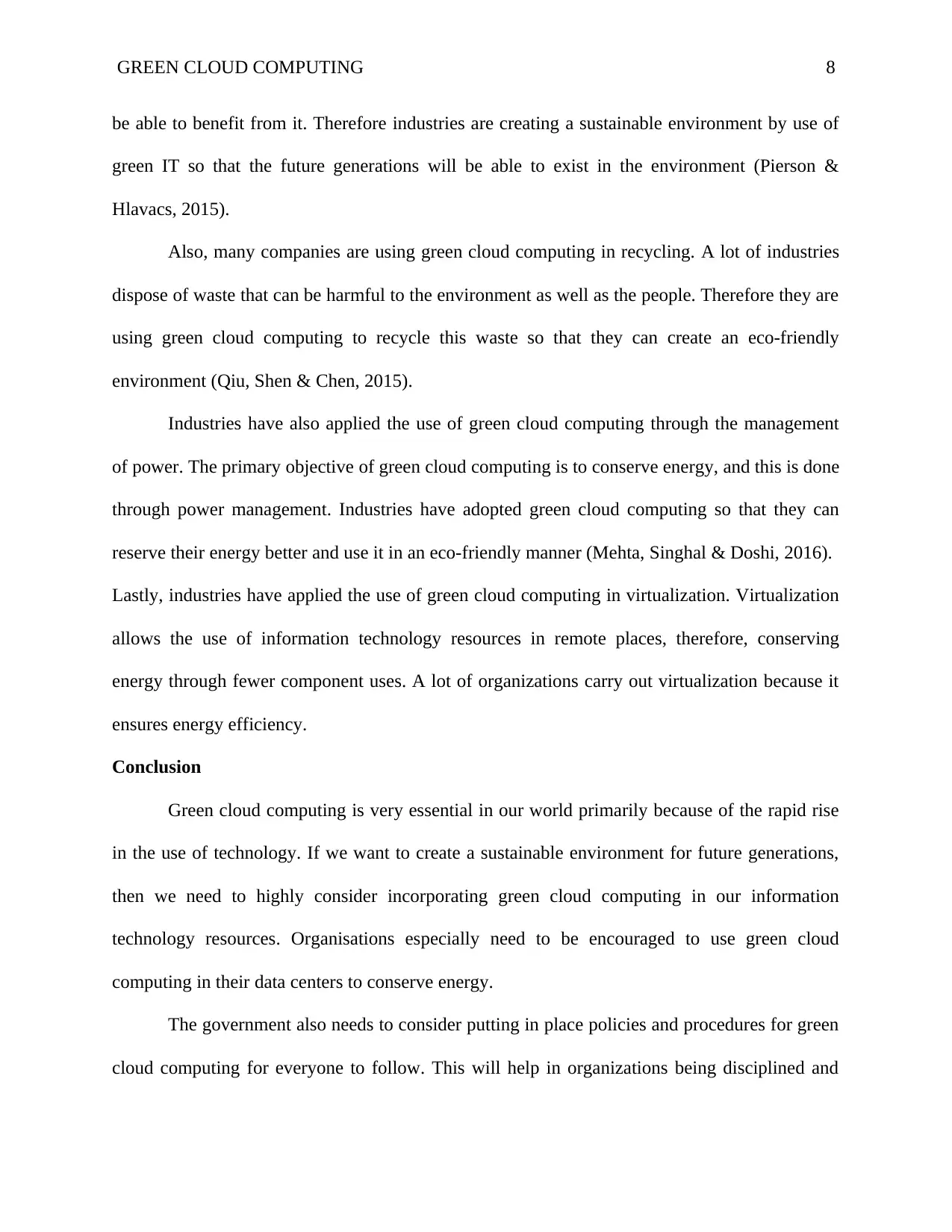
GREEN CLOUD COMPUTING 8
be able to benefit from it. Therefore industries are creating a sustainable environment by use of
green IT so that the future generations will be able to exist in the environment (Pierson &
Hlavacs, 2015).
Also, many companies are using green cloud computing in recycling. A lot of industries
dispose of waste that can be harmful to the environment as well as the people. Therefore they are
using green cloud computing to recycle this waste so that they can create an eco-friendly
environment (Qiu, Shen & Chen, 2015).
Industries have also applied the use of green cloud computing through the management
of power. The primary objective of green cloud computing is to conserve energy, and this is done
through power management. Industries have adopted green cloud computing so that they can
reserve their energy better and use it in an eco-friendly manner (Mehta, Singhal & Doshi, 2016).
Lastly, industries have applied the use of green cloud computing in virtualization. Virtualization
allows the use of information technology resources in remote places, therefore, conserving
energy through fewer component uses. A lot of organizations carry out virtualization because it
ensures energy efficiency.
Conclusion
Green cloud computing is very essential in our world primarily because of the rapid rise
in the use of technology. If we want to create a sustainable environment for future generations,
then we need to highly consider incorporating green cloud computing in our information
technology resources. Organisations especially need to be encouraged to use green cloud
computing in their data centers to conserve energy.
The government also needs to consider putting in place policies and procedures for green
cloud computing for everyone to follow. This will help in organizations being disciplined and
be able to benefit from it. Therefore industries are creating a sustainable environment by use of
green IT so that the future generations will be able to exist in the environment (Pierson &
Hlavacs, 2015).
Also, many companies are using green cloud computing in recycling. A lot of industries
dispose of waste that can be harmful to the environment as well as the people. Therefore they are
using green cloud computing to recycle this waste so that they can create an eco-friendly
environment (Qiu, Shen & Chen, 2015).
Industries have also applied the use of green cloud computing through the management
of power. The primary objective of green cloud computing is to conserve energy, and this is done
through power management. Industries have adopted green cloud computing so that they can
reserve their energy better and use it in an eco-friendly manner (Mehta, Singhal & Doshi, 2016).
Lastly, industries have applied the use of green cloud computing in virtualization. Virtualization
allows the use of information technology resources in remote places, therefore, conserving
energy through fewer component uses. A lot of organizations carry out virtualization because it
ensures energy efficiency.
Conclusion
Green cloud computing is very essential in our world primarily because of the rapid rise
in the use of technology. If we want to create a sustainable environment for future generations,
then we need to highly consider incorporating green cloud computing in our information
technology resources. Organisations especially need to be encouraged to use green cloud
computing in their data centers to conserve energy.
The government also needs to consider putting in place policies and procedures for green
cloud computing for everyone to follow. This will help in organizations being disciplined and
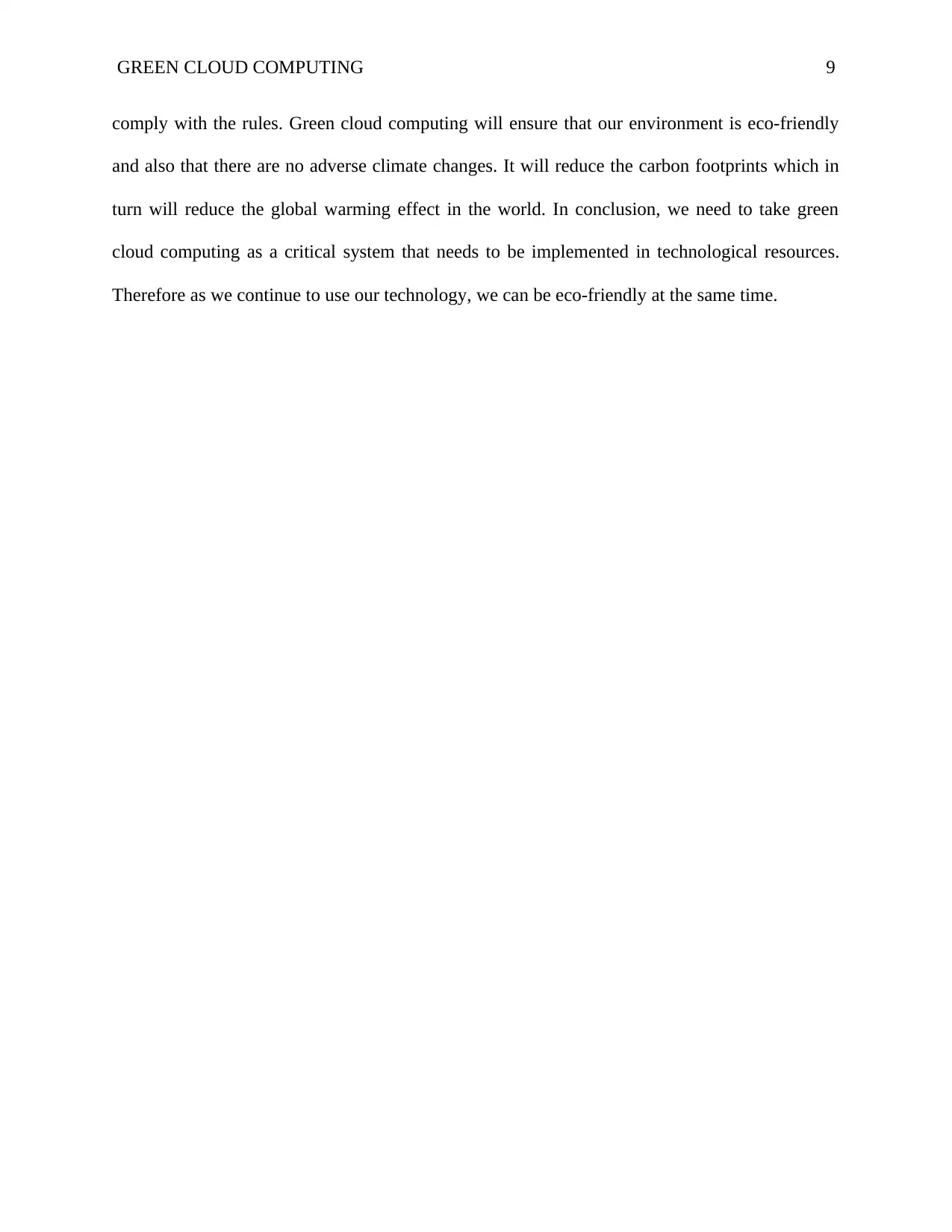
GREEN CLOUD COMPUTING 9
comply with the rules. Green cloud computing will ensure that our environment is eco-friendly
and also that there are no adverse climate changes. It will reduce the carbon footprints which in
turn will reduce the global warming effect in the world. In conclusion, we need to take green
cloud computing as a critical system that needs to be implemented in technological resources.
Therefore as we continue to use our technology, we can be eco-friendly at the same time.
comply with the rules. Green cloud computing will ensure that our environment is eco-friendly
and also that there are no adverse climate changes. It will reduce the carbon footprints which in
turn will reduce the global warming effect in the world. In conclusion, we need to take green
cloud computing as a critical system that needs to be implemented in technological resources.
Therefore as we continue to use our technology, we can be eco-friendly at the same time.
⊘ This is a preview!⊘
Do you want full access?
Subscribe today to unlock all pages.

Trusted by 1+ million students worldwide
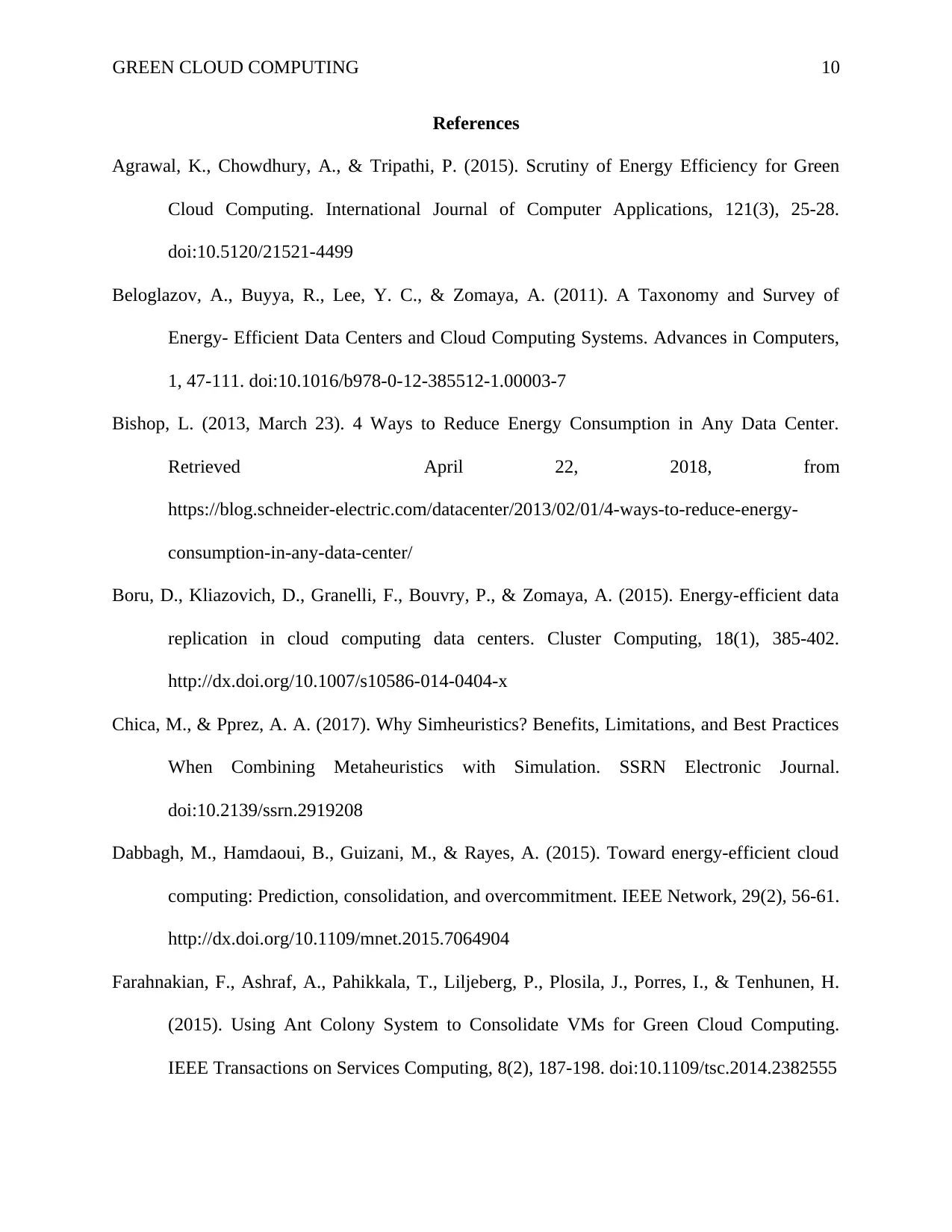
GREEN CLOUD COMPUTING 10
References
Agrawal, K., Chowdhury, A., & Tripathi, P. (2015). Scrutiny of Energy Efficiency for Green
Cloud Computing. International Journal of Computer Applications, 121(3), 25-28.
doi:10.5120/21521-4499
Beloglazov, A., Buyya, R., Lee, Y. C., & Zomaya, A. (2011). A Taxonomy and Survey of
Energy- Efficient Data Centers and Cloud Computing Systems. Advances in Computers,
1, 47-111. doi:10.1016/b978-0-12-385512-1.00003-7
Bishop, L. (2013, March 23). 4 Ways to Reduce Energy Consumption in Any Data Center.
Retrieved April 22, 2018, from
https://blog.schneider-electric.com/datacenter/2013/02/01/4-ways-to-reduce-energy-
consumption-in-any-data-center/
Boru, D., Kliazovich, D., Granelli, F., Bouvry, P., & Zomaya, A. (2015). Energy-efficient data
replication in cloud computing data centers. Cluster Computing, 18(1), 385-402.
http://dx.doi.org/10.1007/s10586-014-0404-x
Chica, M., & Pprez, A. A. (2017). Why Simheuristics? Benefits, Limitations, and Best Practices
When Combining Metaheuristics with Simulation. SSRN Electronic Journal.
doi:10.2139/ssrn.2919208
Dabbagh, M., Hamdaoui, B., Guizani, M., & Rayes, A. (2015). Toward energy-efficient cloud
computing: Prediction, consolidation, and overcommitment. IEEE Network, 29(2), 56-61.
http://dx.doi.org/10.1109/mnet.2015.7064904
Farahnakian, F., Ashraf, A., Pahikkala, T., Liljeberg, P., Plosila, J., Porres, I., & Tenhunen, H.
(2015). Using Ant Colony System to Consolidate VMs for Green Cloud Computing.
IEEE Transactions on Services Computing, 8(2), 187-198. doi:10.1109/tsc.2014.2382555
References
Agrawal, K., Chowdhury, A., & Tripathi, P. (2015). Scrutiny of Energy Efficiency for Green
Cloud Computing. International Journal of Computer Applications, 121(3), 25-28.
doi:10.5120/21521-4499
Beloglazov, A., Buyya, R., Lee, Y. C., & Zomaya, A. (2011). A Taxonomy and Survey of
Energy- Efficient Data Centers and Cloud Computing Systems. Advances in Computers,
1, 47-111. doi:10.1016/b978-0-12-385512-1.00003-7
Bishop, L. (2013, March 23). 4 Ways to Reduce Energy Consumption in Any Data Center.
Retrieved April 22, 2018, from
https://blog.schneider-electric.com/datacenter/2013/02/01/4-ways-to-reduce-energy-
consumption-in-any-data-center/
Boru, D., Kliazovich, D., Granelli, F., Bouvry, P., & Zomaya, A. (2015). Energy-efficient data
replication in cloud computing data centers. Cluster Computing, 18(1), 385-402.
http://dx.doi.org/10.1007/s10586-014-0404-x
Chica, M., & Pprez, A. A. (2017). Why Simheuristics? Benefits, Limitations, and Best Practices
When Combining Metaheuristics with Simulation. SSRN Electronic Journal.
doi:10.2139/ssrn.2919208
Dabbagh, M., Hamdaoui, B., Guizani, M., & Rayes, A. (2015). Toward energy-efficient cloud
computing: Prediction, consolidation, and overcommitment. IEEE Network, 29(2), 56-61.
http://dx.doi.org/10.1109/mnet.2015.7064904
Farahnakian, F., Ashraf, A., Pahikkala, T., Liljeberg, P., Plosila, J., Porres, I., & Tenhunen, H.
(2015). Using Ant Colony System to Consolidate VMs for Green Cloud Computing.
IEEE Transactions on Services Computing, 8(2), 187-198. doi:10.1109/tsc.2014.2382555
Paraphrase This Document
Need a fresh take? Get an instant paraphrase of this document with our AI Paraphraser
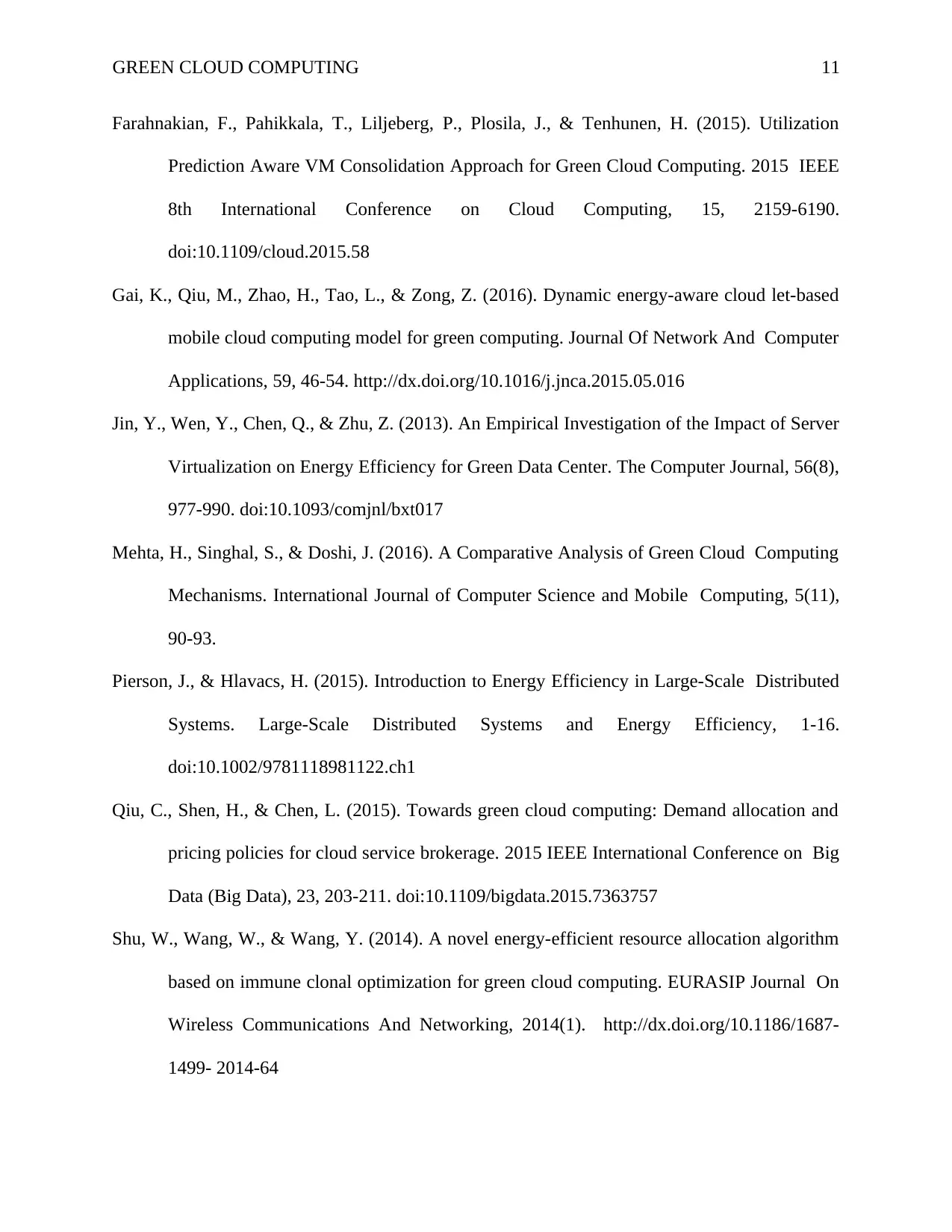
GREEN CLOUD COMPUTING 11
Farahnakian, F., Pahikkala, T., Liljeberg, P., Plosila, J., & Tenhunen, H. (2015). Utilization
Prediction Aware VM Consolidation Approach for Green Cloud Computing. 2015 IEEE
8th International Conference on Cloud Computing, 15, 2159-6190.
doi:10.1109/cloud.2015.58
Gai, K., Qiu, M., Zhao, H., Tao, L., & Zong, Z. (2016). Dynamic energy-aware cloud let-based
mobile cloud computing model for green computing. Journal Of Network And Computer
Applications, 59, 46-54. http://dx.doi.org/10.1016/j.jnca.2015.05.016
Jin, Y., Wen, Y., Chen, Q., & Zhu, Z. (2013). An Empirical Investigation of the Impact of Server
Virtualization on Energy Efficiency for Green Data Center. The Computer Journal, 56(8),
977-990. doi:10.1093/comjnl/bxt017
Mehta, H., Singhal, S., & Doshi, J. (2016). A Comparative Analysis of Green Cloud Computing
Mechanisms. International Journal of Computer Science and Mobile Computing, 5(11),
90-93.
Pierson, J., & Hlavacs, H. (2015). Introduction to Energy Efficiency in Large-Scale Distributed
Systems. Large-Scale Distributed Systems and Energy Efficiency, 1-16.
doi:10.1002/9781118981122.ch1
Qiu, C., Shen, H., & Chen, L. (2015). Towards green cloud computing: Demand allocation and
pricing policies for cloud service brokerage. 2015 IEEE International Conference on Big
Data (Big Data), 23, 203-211. doi:10.1109/bigdata.2015.7363757
Shu, W., Wang, W., & Wang, Y. (2014). A novel energy-efficient resource allocation algorithm
based on immune clonal optimization for green cloud computing. EURASIP Journal On
Wireless Communications And Networking, 2014(1). http://dx.doi.org/10.1186/1687-
1499- 2014-64
Farahnakian, F., Pahikkala, T., Liljeberg, P., Plosila, J., & Tenhunen, H. (2015). Utilization
Prediction Aware VM Consolidation Approach for Green Cloud Computing. 2015 IEEE
8th International Conference on Cloud Computing, 15, 2159-6190.
doi:10.1109/cloud.2015.58
Gai, K., Qiu, M., Zhao, H., Tao, L., & Zong, Z. (2016). Dynamic energy-aware cloud let-based
mobile cloud computing model for green computing. Journal Of Network And Computer
Applications, 59, 46-54. http://dx.doi.org/10.1016/j.jnca.2015.05.016
Jin, Y., Wen, Y., Chen, Q., & Zhu, Z. (2013). An Empirical Investigation of the Impact of Server
Virtualization on Energy Efficiency for Green Data Center. The Computer Journal, 56(8),
977-990. doi:10.1093/comjnl/bxt017
Mehta, H., Singhal, S., & Doshi, J. (2016). A Comparative Analysis of Green Cloud Computing
Mechanisms. International Journal of Computer Science and Mobile Computing, 5(11),
90-93.
Pierson, J., & Hlavacs, H. (2015). Introduction to Energy Efficiency in Large-Scale Distributed
Systems. Large-Scale Distributed Systems and Energy Efficiency, 1-16.
doi:10.1002/9781118981122.ch1
Qiu, C., Shen, H., & Chen, L. (2015). Towards green cloud computing: Demand allocation and
pricing policies for cloud service brokerage. 2015 IEEE International Conference on Big
Data (Big Data), 23, 203-211. doi:10.1109/bigdata.2015.7363757
Shu, W., Wang, W., & Wang, Y. (2014). A novel energy-efficient resource allocation algorithm
based on immune clonal optimization for green cloud computing. EURASIP Journal On
Wireless Communications And Networking, 2014(1). http://dx.doi.org/10.1186/1687-
1499- 2014-64
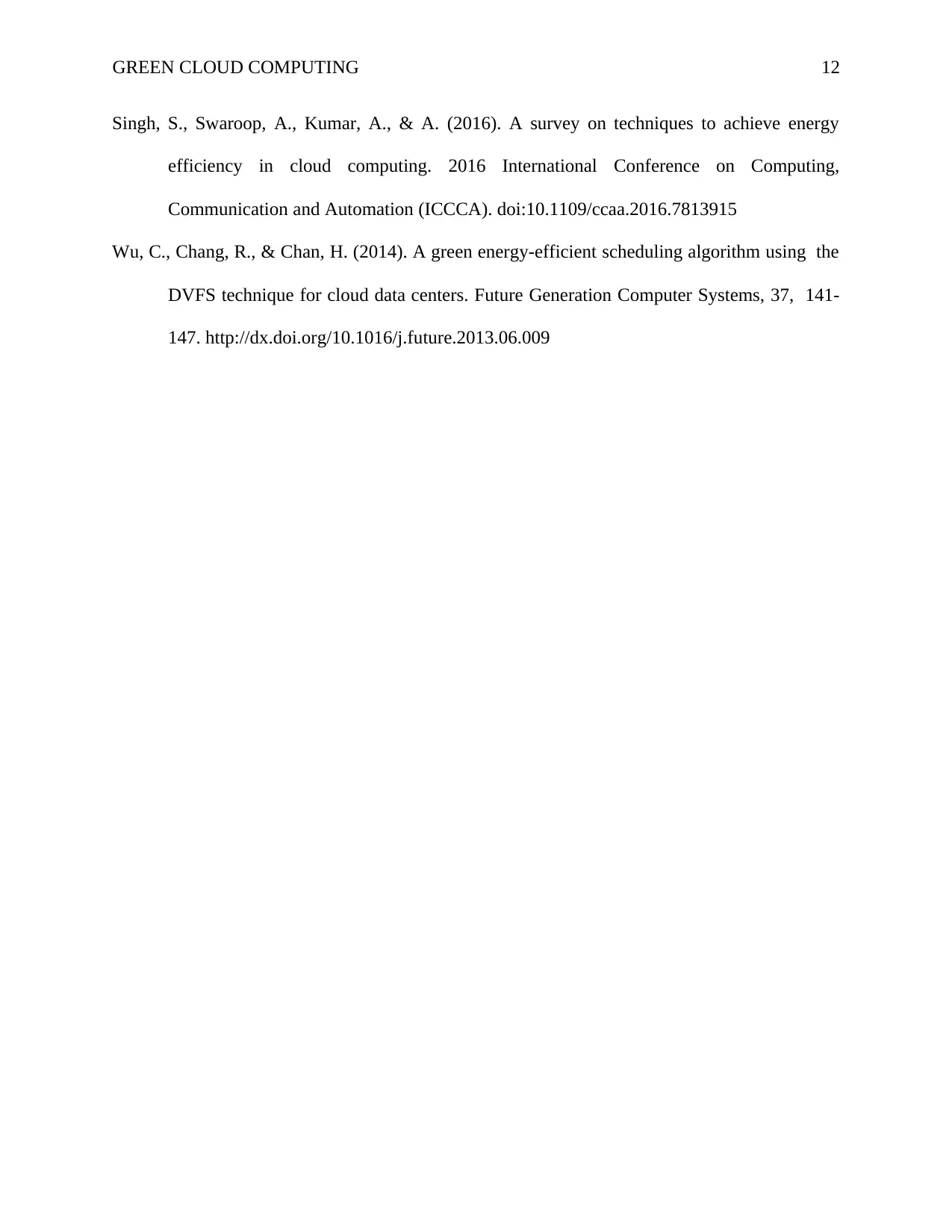
GREEN CLOUD COMPUTING 12
Singh, S., Swaroop, A., Kumar, A., & A. (2016). A survey on techniques to achieve energy
efficiency in cloud computing. 2016 International Conference on Computing,
Communication and Automation (ICCCA). doi:10.1109/ccaa.2016.7813915
Wu, C., Chang, R., & Chan, H. (2014). A green energy-efficient scheduling algorithm using the
DVFS technique for cloud data centers. Future Generation Computer Systems, 37, 141-
147. http://dx.doi.org/10.1016/j.future.2013.06.009
Singh, S., Swaroop, A., Kumar, A., & A. (2016). A survey on techniques to achieve energy
efficiency in cloud computing. 2016 International Conference on Computing,
Communication and Automation (ICCCA). doi:10.1109/ccaa.2016.7813915
Wu, C., Chang, R., & Chan, H. (2014). A green energy-efficient scheduling algorithm using the
DVFS technique for cloud data centers. Future Generation Computer Systems, 37, 141-
147. http://dx.doi.org/10.1016/j.future.2013.06.009
⊘ This is a preview!⊘
Do you want full access?
Subscribe today to unlock all pages.

Trusted by 1+ million students worldwide
1 out of 12
Related Documents
Your All-in-One AI-Powered Toolkit for Academic Success.
+13062052269
info@desklib.com
Available 24*7 on WhatsApp / Email
![[object Object]](/_next/static/media/star-bottom.7253800d.svg)
Unlock your academic potential
Copyright © 2020–2025 A2Z Services. All Rights Reserved. Developed and managed by ZUCOL.




